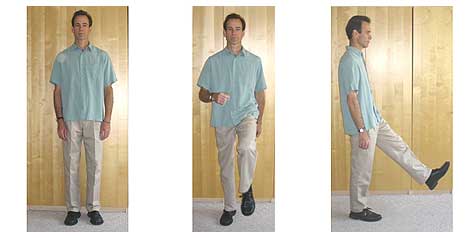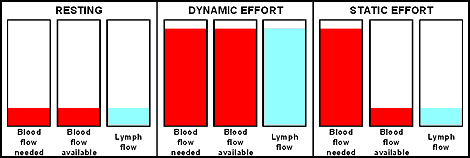Physiological Rationale for Micro-breaks
By Erik Peper, Ph.D. and Katherine H. Gibney¹
San Francisco State University
Abstract
Static muscle effort significantly inhibits blood flow, which may lead to injury, while dynamic muscle efforts, which involves the alternation of tension and relaxation, allow for sufficient blood flow. Taking micro-breaks during static muscle activity, such as working at the computer, changes the effort from static to dynamic. The graphics illustrate the available and required blood flow and lymph flow during rest, dynamic and static efforts. Portable equipment, such as a Myotrac™ with a 60 second feedback delay, is a useful device to signal the person to take a micro-break if the muscle has been held contracted above threshold continuously for 60 seconds. Common electrode locations are illustrated for the use of working at the computer.
Micro-breaks are 1-2 second interruptions of muscle tension every 60 seconds. During use, muscles contract around the blood vessels inhibiting blood flow. If tension is maintained without interruption (static effort), blood, as well as lymph flow, is continuously inhibited at a time when more flow is required. Chronic static effort can result in injury and discomfort, such as found in repetitive motion injury (RMI). When effort is dynamic-that is the alternation of tension and relaxation-blood and lymph are pumped through the muscles and health is maintained. A common example of dynamic effort is standing and walking: we can stand or walk for extended periods of time without discomfort (resting or dynamic effort), because our blood/lymph flow matches our effort. However, if we were to stand holding our leg up (static effort), we would experience discomfort quickly because static effort demands similar blood/lymph flow as dynamic. Below is a simple illustration of the body's need for blood² and lymph flow during activities.


Taking micro-breaks during static muscle activity, such as working at the computer, changes the effort from static to dynamic. A portable EMG biofeedback machine with a 60-second delay alarm, such as the MyoTrac™ produced by Thought Technology, Ltd., is a superb trainer for mastering micro-breaks while working at the computer. A threshold for relaxation is set and, as one works at the computer, the EMG gives an auditory signal whenever the muscle activity is above the set threshold for more than 60 seconds. The 60-second timer resets itself each time the muscle activity drops beneath the threshold. With this feedback, employees can be trained for micro-breaks at the worksite. As they work, they can ensure dynamic effort by taking a micro-break or performing an activity that drops the EMG beneath threshold. If they forget, the feedback signal reminds them to do so.
Common electrode placements for training micro-breaks include forearm extensors or flexors, upper trapezius and anterior/medial deltoid as illustrated below. Detailed electrode placement instructions and strategies on how to use a portable EMG to promote healthy computing and prevent RSI (Repetitive Strain Injury) are found in Peper and Gibney (2000).

Many patients and clients whom we have trained report a significant increase in energy combined with a decrease in discomfort when they report taking micro-breaks when keyboarding and mousing. Although brief breaks are commonly recommended by ergonomists, equipment manufacturers and health care professionals, people generally do not relax muscles when more work is sitting in front of them, even though they may be resting their hands in their laps. The portable EMG, with a 60-second alarm, can help them develop awareness of what is truly resting.
Reference
Peper, E., & Gibney, K.H. (2000). Healthy computing with muscle biofeedback: A practical manual for preventing repetitive motion injury. Woerden: Biofeedback Foundation of Europe. (Available in the USA from: Work Solutions USA, 2236 Derby Street, Berkeley, CA 94705. It can be ordered from: www.mindgrowth.com)
Footnotes
- We thank Christopher Gibney, L.A.C., DHOM and Laura Peper for generously volunteering to be models.
- Adapted from Grandjean, E. (1987). Ergonomics in Computerized Offices. New York: Taylor and Francis.


